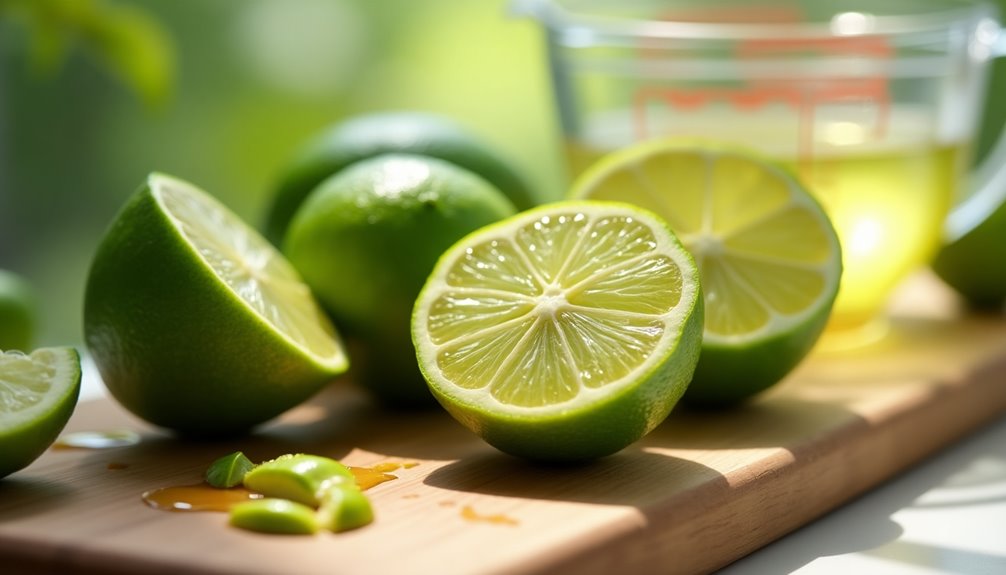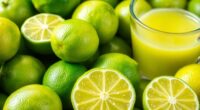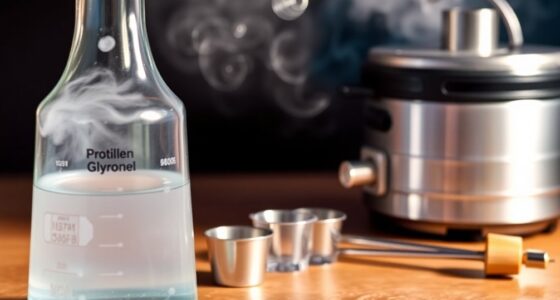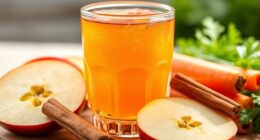To make a half cup of juice, you'll need about four medium Persian limes or around twenty smaller Key limes. Choose limes that feel heavy with smooth, firm rinds for maximum juice. Rolling the limes before cutting helps release even more juice. If you plan on juicing, it's smart to have an extra lime or two on hand, just in case. There's more to learn about selecting and preparing limes for the best juice possible.
Key Takeaways
- For half a cup of juice, you'll need about 4 medium Persian limes.
- Approximately 20 Key limes are required to yield a half cup of juice.
- Juice yield can vary based on the lime's type, ripeness, and size.
- Always choose heavy limes with smooth, firm rinds for better juice content.
- Keep extra limes handy to account for variability in juice yield.

Have you ever wondered how many limes you really need to squeeze for that perfect half cup of lime juice? You're not alone in this quest for the ideal amount. Whether you're whipping up a zesty cocktail or adding a tangy twist to your favorite dish, knowing how many limes to use is key. The answer can vary quite a bit depending on the type of lime you're working with.
If you're using medium Persian limes, you'll typically need about four of them to yield that coveted half cup of fresh juice. Each of these limes generally produces around two tablespoons of juice, and since a half cup equals eight tablespoons, four limes will get you right where you need to be. When you're at the grocery store, look for limes that feel heavy for their size and have smooth, firm rinds. These characteristics usually indicate a higher juice content, so you'll end up with more juice in less time.
On the other hand, if you decide to use Key limes, the situation changes dramatically. These little gems are smaller and have a lower juice yield compared to their Persian counterparts. To get that same half cup of juice, you might need about twenty Key limes! That's a lot of squeezing, but if you love the unique flavor of Key limes, it could be worth the effort. Just keep in mind that you'll spend a lot more time at the cutting board if you go this route.
Juice yield can also fluctuate based on factors like ripeness and size. Sometimes, you might get lucky and find a particularly juicy lime that yields more than expected. Other times, you might squeeze and squeeze, only to find yourself falling short. That's why it's always a good idea to have an extra lime or two on hand. After all, you wouldn't want to be caught in the middle of a recipe, only to realize you don't have enough juice.
Once you've got your limes, the process is pretty straightforward. Just slice them in half and give them a good squeeze. You could also use a juicer if you have one, which can really save your hands from fatigue.
Remember to roll the limes on your cutting board before cutting them. This helps to break down the internal membranes and can increase the amount of juice you get out of each lime.
Frequently Asked Questions
How Many Limes Make 1/2 Cup of Juice?
When you're looking to make 1/2 cup of lime juice, you'll need about 4 medium Persian limes. Each of those limes typically gives you around 2 tablespoons of juice, and since 1/2 cup equals 8 tablespoons, that adds up perfectly.
If you're using Key limes, though, you'd need around 12 to 20, as they yield less juice.
Always pick firm, smooth-skinned limes for the best results!
How Many Limes to Make a Half Cup?
To make a half cup of juice, you'll need about 4 medium Persian limes. Each lime typically gives you around 2 tablespoons of juice, and since a half cup equals 8 tablespoons, 4 limes will do the trick.
If you're using key limes, you'll need many more—around 20—since they're smaller and yield less juice.
Always pick firm, heavy limes for the best juice extraction!
How Many Lemons for 1/2 Cup of Juice?
To make 1/2 cup of lemon juice, you'll need about 2 to 3 medium-sized lemons. Each lemon usually yields around 3 tablespoons of juice, and since 1/2 cup is 8 tablespoons, you can see why you need that amount.
Rolling the lemons on the countertop before juicing helps you get the most juice out of them. Fresh juice is always best, but bottled can work in a pinch if you're out of fresh lemons.
Can I Use Regular Limes in Place of Key Limes?
Yes, you can use regular limes in place of key limes, but keep in mind that the flavor will be different.
Regular limes have a milder taste and less acidity, so your dish mightn't have the same intensity.
You'll likely need to adjust the amount of lime juice to achieve your desired tartness.
Experiment a bit to find the right balance, and enjoy the unique flavors each lime variety brings!
Conclusion
In the garden of flavor, each lime is a little sunbeam waiting to burst forth with zest. To gather a cup and a half of juice, you'd need about 8 to 10 limes, each one a treasure trove of tangy delight. As you squeeze and pour, imagine you're collecting the sunshine itself, brightening your drink and your day. So, embrace the dance of lime and let their vibrant essence transform your beverage into a refreshing oasis.
Cindy thoroughly researches juicing trends, techniques, and recipes to provide readers with practical advice and inspiration. Her writing style is accessible, engaging, and designed to make complex concepts easy to understand. Cindy’s dedication to promoting the advantages of juicing shines through her work, empowering readers to make positive changes in their lives through the simple act of juicing.











